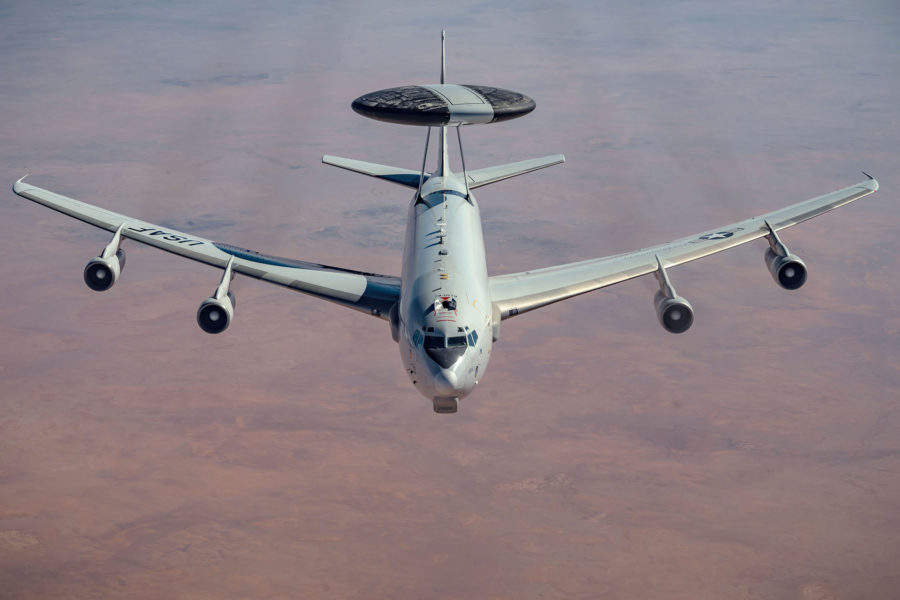The E-3 Airborne Warning and Control System (AWACS) is a heavily modified Boeing 707-320B tasked with all-weather, air and maritime surveillance, command and control, battle management, target, threat, and emitter detection, classification, and tracking.
The aircraft is capable of surveilling airspace in excess of a 250-mile radius from surface to stratosphere. AWACS coordinates theater air operations in direct subordination to joint/combined air and space operations centers. It can simultaneously conduct C2, BM, and target detection/tracking. E-3Bs were upgraded to Block 30/35 standards in 2001.

Block 40/45 aircraft are redesignated E-3G. The upgrade is the most comprehensive enhancement to date and improves tracking/identification, system reliability, and life-cycle cost. Mods include open-architecture computing, operator workload reduction, new consoles, improved electronic support measures (ESM), and passive surveillance capability. DRAGON (Diminishing manufacturing sources Replacement of Avionics for Global Operations and Navigation) upgrades add a digital cockpit and next-generation CNS/GATM. Four USAF aircraft are slated for DRAGON in FY23 and mods to remaining aircraft are now expected by 2025.
Development includes Electronic Protection (EP) to improve radar processing for classified requirements, modernizing airborne moving target indication, and fourth- to fifth-generation connectivity (to integrate F-22 and F-35). Ongoing mods include accelerated Mode 5 IFF install (as an airspace compliance bridge to DRAGON), Communication Network Upgrade (CNU) to add high-speed jam-resistant Link 16, and high-bandwidth internet to quickly prosecute time-sensitive targets. FY23 begins AWACS Communications Integration Program (ACIP) which will include BLOS SATCOM/second-generation NATO UHF, and anti-jam GPS. An E-3G demonstrated the ability to receive in-flight EW updates to counter emergent threats during a proof-of-concept demo in 2022.
USAF aims to replace AWACS with a space-based capability. Due to a lack of mature space-based system and difficulty sustaining Sentry, the service issued Boeing a $1.2 billion contract to replace a portion of the AWACS fleet with the E-7A Wedgetail. USAF curtailed E-3 modernization starting in FY23 to fund E-7A, fielding two prototypes for testing by 2027. The service plans to retire 15 Sentrys in FY23, freeing resources to improve the remaining fleet’s availability until retirement in FY29.
Contractors: Boeing, Northrop Grumman (radar); Lockheed Martin (computer); Rockwell Collins (DRAGON cockpit upgrade).
First Flight: Oct. 31, 1975 (full avionics).
Delivered: March 1977-1984.
IOC: 1977; July 28, 2014 (Block 40/45).
Production: 31.
Inventory: Eight (E-3B); 23 (E-3G).
Operator: ACC, PACAF, AFRC (associate).
Aircraft Location: JB Elmendorf-Richardson, Alaska; Kadena AB, Japan; Tinker AFB, Okla.
Active Variants: •E-3B. Block 30/35 upgraded aircraft. •E-3C. Block 30/35 upgraded aircraft with additional advanced capabilities. •E-3G. Block 40/45 upgraded aircraft.
Dimensions: Span 145.8 ft, length 152.9 ft, height 41.8 ft.
Weight: Max T-O 335,000 lb.
Power Plant: Four Pratt & Whitney TF33-PW-100A turbofans, each 21,000 lb thrust.
Performance: Speed 360 mph, range 5,000+ miles (air refuelable).
Ceiling: Above 35,000 ft.
Accommodation: Two pilots, navigator, flight engineer, 13-19 mission specialists.
